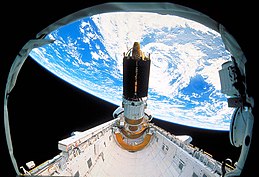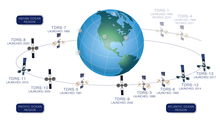cosmos.wikisort.org - Spacecraft
TDRS-4, known before launch as TDRS-D, is an American communications satellite, of first generation, which was operated by NASA as part of the Tracking and Data Relay Satellite System from 1989 until 2011. It was constructed by TRW, based on a custom satellite bus which was used for all seven of the first generation TDRS satellites.[3]
 TDRS-D being deployed from Discovery | |
| Mission type | Communication |
|---|---|
| Operator | NASA |
| COSPAR ID | 1989-021B |
| SATCAT no. | 19883 |
| Mission duration | Planned: 10 years Final: 22 years, 9 months |
| Spacecraft properties | |
| Bus | TDRS |
| Manufacturer | TRW |
| Launch mass | 2,108 kg (4,647 lb) [1] |
| Dimensions | 17.3 × 14.2 m (57 × 47 ft) |
| Power | 1700 watts |
| Start of mission | |
| Launch date | 13 March 1989, 14:57:00 UTC |
| Rocket | Space Shuttle Discovery STS-29R / IUS |
| Launch site | Kennedy Space Center, LC-39B |
| Contractor | Rockwell International |
| End of mission | |
| Disposal | Retired to graveyard |
| Declared | December 2011 |
| Deactivated | May 2012 |
| Orbital parameters | |
| Reference system | Geocentric orbit |
| Regime | Geostationary orbit |
| Longitude | 41.0° West (1988–2005) 46.0° West (2005–2011) |
| Epoch | 14 March 1989 [2] |
History

TDRS-D was launched aboard Space Shuttle Discovery during the STS-29 mission in 1989. Discovery launched from Launch Complex 39B at the Kennedy Space Center at 14:57:00 UTC on 13 March 1989.[4] TDRS-D was deployed from Discovery a few hours after launch, and was raised to geostationary orbit by means of an Inertial Upper Stage.[4]
Deployment
The twin-stage solid-propellant Inertial Upper Stage made two burns. The first stage burn occurred shortly after deployment from Discovery, and placed the satellite into a geostationary transfer orbit (GTO). At 03:30 UTC on 14 March 1989, it reached apogee, and the second stage fired, placing TDRS-D into geostationary orbit.[5] At this point, it received its operational designation, TDRS-4. It was placed at a longitude 41.0° West of the Greenwich Meridian,[6][7] from where it provided communications services to spacecraft in Earth orbit, including the Space Shuttle and International Space Station. In 2005, it was relocated to 46.0° West.[6]
Retirement
TDRS-4 completed its planned mission in December 2011, and was subsequently removed to a graveyard orbit 350 kilometres (220 mi) above GEO orbit belt, per International Telecommunication Union (ITU) and United Nations (UN) recommendations.[8] In May 2012, NASA reported that the orbit-raising manoeuvre had been completed successfully, and the spacecraft had been retired.[9]


See also
- List of TDRS satellites
References
- "UCS Satellite Database". Union of Concerned Scientists. 1 July 2009. Retrieved 9 August 2009.
- "NASA – NSSDCA – Spacecraft – Trajectory Details". nssdc.gsfc.nasa.gov. Retrieved 2 May 2018.
 This article incorporates text from this source, which is in the public domain.
This article incorporates text from this source, which is in the public domain. - Krebs, Gunter. "TDRS 1, 2, 3, 4, 5, 6". Gunter's Space Page. Retrieved 9 August 2009.
- McDowell, Jonathan. "Launch Log". Jonathan's Space Page. Retrieved 9 August 2009.
- McDowell, Jonathan. "Index". Geostationary Orbit Catalog. Jonathan's Space Page. Retrieved 9 August 2009.
- "TDRS 4". TSE. Retrieved 9 August 2009.
- "The TDRS-J satellite". Spaceflight Now. 1 December 2002. Retrieved 9 August 2009.
- Johnson, Nicholas (5 December 2011). "Space debris issues". audio file, @1:03:05-1:05:10. The Space Show. Archived from the original on 27 January 2012. Retrieved 8 December 2011.
- "TDRS-4 Mission Complete; Spacecraft Retired From Active Service". NASA. 8 May 2012. Retrieved 11 May 2012.
 This article incorporates text from this source, which is in the public domain.
This article incorporates text from this source, which is in the public domain.
Другой контент может иметь иную лицензию. Перед использованием материалов сайта WikiSort.org внимательно изучите правила лицензирования конкретных элементов наполнения сайта.
WikiSort.org - проект по пересортировке и дополнению контента Википедии
